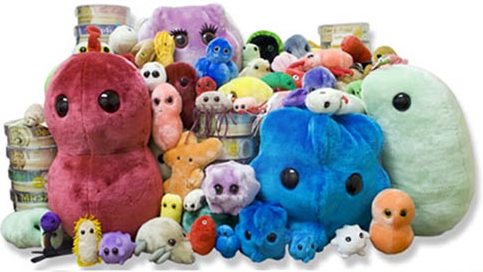Pandemic Flu (Influenza A virus H1N1)
Out of Stock
Swine flu is an influenza virus that usually affects pigs. However, just as the common, seasonal flu that affects humans is constantly mutating (as our immune systems and vaccines compromise weaker strains), swine flu is always trying to improve itself so that it can become more virulent, spread faster – and even associate with better company.
Product Details
Additional Information
| Sizes | Giantmicrobes are based on actual microbes, cells, organisms and other critters, only 1,000,000 times actual size! Gigantic (GG) 16-24" XL (XL) 10-15" Original (PD) 5-8" Keychain (KC) 2-4" with clip |
|---|---|
| Materials | Plush from all new materials. Stuffed with polyester fiber fill. Surface washable: sponge with water & soap, air dry. |
| Packaging | Each plush microbe includes a printed card with fun, educational and fascinating facts about the actual microbe or cell. |
| Safety | Every product meets or exceeds U.S. and European standards for safety. For ages 3 and up. |
All about Pandemic Flu (Influenza A virus H1N1)
FACTS: Swine flu is an influenza virus that usually affects pigs. However, just as the common, seasonal flu that affects humans is constantly mutating (as our immune systems and vaccines compromise weaker strains), swine flu is always trying to improve itself so that it can become more virulent, spread faster – and even associate with better company.
Occasionally, a pig-headed virus such as Influenza A (H1N1) actually succeeds and begins infecting other species – like humans. Naturally, this raises philosophical questions as to whether it is still a swine flu: since it’s new, it isn’t widespread in the porcine population – and anyway, once it’s affecting other species, well…
Nevertheless, once a virus such as swine flu makes the jump to another species, the health risks in the new population are substantial. In the original host-population, some immunities generally exist against the original strain, and these immunities are often at least partially effective against new mutations. In a new host, however, there may be no natural immunity to the original strain and no partial immunity to the new strain – so the virus can spread rapidly. In addition, a virus that produces mild effects in one species may be life-threatening in another – so catastrophic health consequences can result.
Fortunately, swine flu viruses are generally fragile, and in most cases basic health precautions (such as hand-washing and avoiding close contact with those who are ill) significantly reduce the chance of infection. Nevertheless, the dangers of future mutations and infections will continue to abound until, well, pigs fly.
| Name | 2009 H1N1 |
|---|
| Actual Size | The average influenza virus is about .12 microns in size. |
|---|
| Where It Lives | Though many thought the swine flu came from swines, this swine flu, 2009 H1N1, lives in humans! |
|---|
| System | Swine flu passes from person to person similar to how the seasonal flu is passed on: through contact with infected droplets expelled by either coughing or sneezing. Swine flu can also be caught by consuming infected, uncooked bird or fowl. |
|---|
| Cure | Vaccines are available for swine flu. |
|---|
| Deadliness/Severity | The WHO estimated that around 18,000 people were killed, but the actual number may be from 100,000 to 200,000! |
|---|
| Infectiousness | The virus is spread from person to person either through coughing, sneezing, or contact with an infected surface. |
|---|
| History |
In the spring of 2009 a new flu virus broke out in the United States and other countries; the world braced itself for a pandemic. Since the virus was linked to the virus found in pigs, the virus was coined the “swine” flu. By June, 2009, the swine flu had affected 18,000 people and spread to 74 countries. In the months following, the 2009 H1N1 vaccine was manufactured and distributed to target areas. |
|---|
| Fascinating Facts | Although many people believed that exposure to pigs would result in catching the swine flu, it was found that the swine flu was actually circulated by humans, not pig herds! |
|---|





